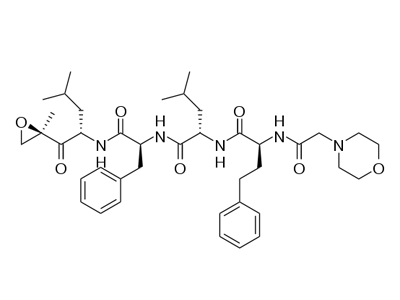High-Dose Carfilzomib Could Prove More Effective in Myeloma
Carfilzomib given at a higher dose as a slow intravenous infusion over 30 minutes resulted in a very high response rate in a heavily pretreated myeloma population.
Chemical structure of carfilzomib

Carfilzomib when given at a dose of 56 mg/m2 as a slow intravenous infusion over 30 minutes resulted in a very high response rate in a heavily pretreated myeloma population, according to the results of a phase II study published recently in Blood.
“The results suggest that carfilzomib 56 mg/m2 with or without dexamethasone may provide added benefit with respect to depth of response and duration of response compared with the currently approved 20/27 mg/m2 dose of single-agent carfilzomib,” study author Nikoletta Lendvai, MD, PhD, of Memorial Sloan Kettering Cancer Center, told Cancer Network. “Importantly, adding low-dose dexamethasone to carfilzomib may allow patients to prolong treatment, which is clinically meaningful in the advanced multiple myeloma setting where salvage treatment options are limited.”
At this time, there is no established cure for multiple myeloma. Patients whose disease has relapsed multiple times and who have aggressive disease or whose disease has become refractory to bortezomib and lenalidomide have few good options for treatment.
Carfilzomib is currently approved by the US Food and Drug Administration for multiple myeloma that has relapsed or is refractory to treatment with at least two prior therapies, including bortezomib and an immunomodulatory derivative.
Previously, the PX-171-003 A1 study analyzed patients who received single-agent carfilzomib 20 mg/m2 intravenously twice weekly for 3 of 4 weeks in cycle 1, then 27 mg/m2 for up to 12 cycles. The study showed that patients had an overall response rate of 23.7% with a median duration of response of 7.8 months. Median overall survival was 15.6 months in this heavily treated population. In this and other phase II studies at the time, carfilzomib was given as a 10 minute intravenous infusion, Lendvai said.
Preclinical studies suggested that giving carfilzomib as a slower infusion, over 30 minutes, may result in better tolerability and allow for administration of higher doses of carfilzomib. Phase Ib data showed that this is indeed the case and identified 56 mg/m2 as the maximum tolerated dose when carfilzomib is given as a slow infusion, over 30 minutes.
In this study, Lendvai and colleagues conducted an investigator-initiated, single center study to further evaluate the efficacy and safety of carfilzomib when given at 56 mg/m2 dose as a slow intravenous infusion over 30 minutes in patients who had relapsed and/or refractory multiple myeloma.
The researchers enrolled 44 patients, of whom 42 were evaluable for response. Fifty-five percent of patients achieved a partial response or better with four requiring the addition of dexamethasone for suboptimal response or progression.
The median duration of response was 11.7 months. The median progression-free and overall survival was 4.1 months and 20.3 months, respectively.
“The regimen also appears to overcome, at least partially, high-risk cytogenetic markers; ie, we found that patients with adverse cytogenetic markers had responses similar to those without adverse cytogenetic markers,” Lendvai said, adding that future studies with larger sample size are needed to confirm this observation.
As expected, overall, patients who were refractory to bortezomib had poorer overall survival compared with non-refractory patients. Interestingly, bortezomib-refractory patients who did respond to carfilzomib at 56 mg/m2 had a similar duration of response to bortezomib-sensitive patients (10.5 months vs 12.5 months).
The most commonly occurring grade 3/4 adverse events were lymphopenia (43%), thrombocytopenia (32%), hypertension (25%), pneumonia (18%), and heart failure (11%).
The researchers noted that many of the patients were heavily pretreated and had underlying cardiovascular disease. Almost all patients who had grade 3/4 hypertension had pre-existing hypertension.
According to Lendvai, close monitoring of blood pressure and tight control of pre-existing hypertension is an important component of the care of these patients. Avoidance of over-hydration and close attention to fluid status is also likely to be beneficial.
Navigating AE Management for Cellular Therapy Across Hematologic Cancers
A panel of clinical pharmacists discussed strategies for mitigating toxicities across different multiple myeloma, lymphoma, and leukemia populations.